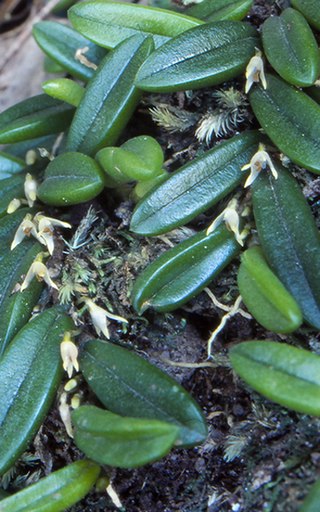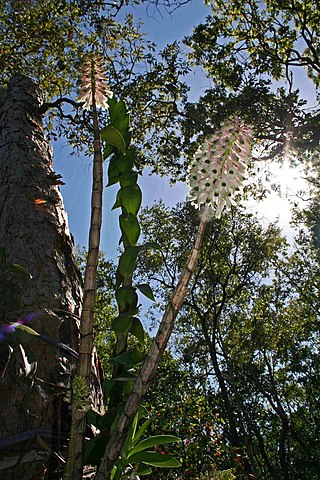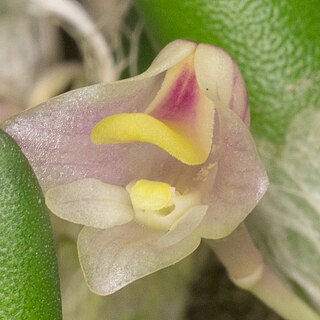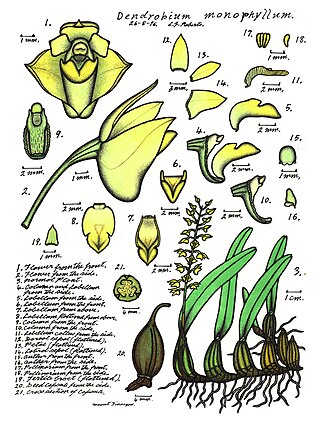
Dendrobium gracilicaule, commonly known as the blotched cane orchid or yellow cane orchid, is an epiphytic or lithophytic orchid in the family Orchidaceae. It has cylindrical pseudobulbs, between three and seven thin leaves and up to thirty often drooping, cream-coloured to yellow or greenish flowers, sometimes with reddish brown blotches on the back. There are two varieties, one occurring in Queensland and New South Wales and the other on some Pacific Islands, including Lord Howe Island.

Bulbophyllum baileyi, commonly known as the fruit fly orchid, is a species of epiphytic or lithophytic orchid that is native to Queensland and New Guinea. It has coarse, creeping rhizomes, curved, yellowish pseudobulbs with a single thick, fleshy leaf, and a single cream-coloured flower with yellow, red or purple spots. It grows on trees and rocks in open forest, often in exposed places.

Bulbophyllum elisae, commonly known as the pineapple orchid, is a species of epiphytic or lithophytic orchid that is endemic to eastern Australia. It has crowded, wrinkled, pale green or yellowish clump-forming pseudobulbs, stiff, pale green to yellowish leaves and between three and twelve pale green to dark green flowers with a dark red to purple labellum. It usually grows in the tops of rainforest trees, on cliff faces or boulders.

Bulbophyllum exiguum, commonly known as the tiny strand orchid, is a species of epiphytic or lithophytic orchid that is endemic to eastern Australia. It has small, roughly spherical pseudobulbs each with a single leaf and up to three small creamy white to yellow flowers emerging from the base of the pseudobulb. This orchid grows in rainforest and dry forest where it often covers the branches of trees or rocks on which it grows.
Bulbophyllum minutissimum, commonly known as the red bead orchid or grain-of-wheat orchid, is a species of epiphytic or lithophytic orchid with small, flattened, reddish or green pseudobulbs, scale-like leaves and small whitish to reddish flowers with broad dar red stripes. It grows on trees and rocks, mostly in swamps and near streams in eastern Australia.
Bulbophyllum nematopodum, commonly known as the green cowl orchid, is a species of epiphytic or lithophytic orchid that has small, flask-shaped pseudobulbs pressed against the surface on which it grows. Each pseudobulb has roots at its base, a single shiny, fleshy leaf and a single cream-coloured flower with red spots on its top. It grows on trees and rocks in rainforest and is endemic to tropical North Queensland.

Bulbophyllum shepherdii, commonly known as the wheat-leaf rope orchid, is a species of epiphytic or lithophytic orchid that forms a dense mat of branching rhizomes pressed against the surface on which it grows. The pseudobulbs are well spaced along the rhizome, each with a single egg-shaped leaf and a single small, white or cream-coloured flower with yellow tips. It grows on trees and rocks in rainforest and is endemic to eastern Australia.

Dendrobium smillieae, commonly known as the bottlebrush orchid, is an epiphytic or lithophytic orchid with large, spongy pseudobulbs, thin, bright green leaves which are shed after their first year and crowded flowers in a bottlebrush-like arrangement. The flowers are white, to cream-coloured or pink and the labellum has a shiny, dark green tip. This orchid species is found in some of the Torres Strait Islands, and through Cape York Peninsula to Townsville, Queensland. It is also found in New Guinea and eastern Indonesia.
Dendrobium macropus, commonly known as the Norfolk Island cane orchid, is a species of epiphytic or lithophytic orchid in the family Orchidaceae and is endemic to Norfolk Island. It has cylindrical pseudobulbs, thin, dark green leaves and between five and ten yellowish green flowers that do not open widely.

Dendrobium adae, commonly known as the slender cane orchid, is an epiphytic, sometimes lithophytic orchid in the family Orchidaceae. It has cylindrical pseudobulbs, up to four dark green leaves and up to six white or greenish to apricot-coloured flowers. It grows in tropical North Queensland, Australia.

Dendrobium agrostophyllum, the buttercup orchid, is an epiphytic or lithophytic orchid in the family Orchidaceae and has a creeping rhizome with well-spaced pseudobulbs. Each pseudobulb has up to twenty grass-like leaves, some of the leaves having flowering stems on the opposite side of the pseudobulb, each raceme with up to ten waxy, fragrant, bright yellow flowers. It grows in wet forest in coast areas of north Queensland, Australia.

Dendrobium baileyi, commonly known as the blotched gemini orchid, is an epiphytic or lithophytic orchid in the family Orchidaceae and has arching stems and flowering stems with one or two spidery, yellow flowers with dark purple spots emerging from leaf axis. It grows in tropical North Queensland, New Guinea and the Solomon Islands.
Dendrobium fellowsii, commonly known as the native damsel orchid, is an epiphytic or lithophytic orchid in the family Orchidaceae and has upright pseudobulbs, up to five leaves and groups of up to five pale green or yellowish flowers with a deep purple labellum. It grows in tropical North Queensland.

Dendrobium lichenastrum, commonly known as the common button orchid, is a species of epiphytic or lithophytic orchid endemic to far north Queensland. It has a creeping, branching rhizome surrounded by papery bracts, small egg-shaped to round, fleshy, dark green leaves and a single white, cream-coloured or pink flower with red stripes and an orange labellum.

Dendrobium monophyllum, commonly known as the lily-of-the-valley orchid, is an epiphytic or lithophytic orchid in the family Orchidaceae. It has pale green to yellowish pseudobulbs with one or two leaves, and between five and twenty bell-shaped yellow flowers. It grows in rainforest in New South Wales and Queensland, Australia.
Dendrobium mortii, commonly known as the slender pencil orchid, is a species of orchid that is endemic to eastern Australia. It is an epiphyte with hanging stems and leaves and flowering stems with up to three pale green to dark green flowers. The flowers have a white labellum with purple markings. It usually grows near the tops of rainforest trees that are often shrouded in mist.

Dendrobium taylorii, commonly known as the smooth burr orchid, is an epiphytic or lithophytic orchid in the family Orchidaceae and is endemic to tropical North Queensland, Australia. It has a single leathery, dark green leaf on a cylindrical stem and one or two small white flowers. Unlike other burr orchids, this species is insect-pollinated. It grows in rainforest, mangroves and sheltered forests.

Pomatocalpa macphersonii, commonly known as the blotched bladder orchid, is an epiphytic or lithophytic orchid with thick, cord-like roots, between two and eight dark green, leathery leaves and up to thirty cup-shaped, yellow flowers with red blotches and a white labellum with red blotches. It usually grows on rainforest trees and is found in New Guinea and tropical North Queensland, Australia.

Sarcochilus hillii, commonly known as myrtle bells, is a small epiphytic orchid native to eastern Australia and New Caledonia. It has up to ten drooping, quill-shaped leaves and up to ten frosty white or pink flowers that have a hairy labellum with purple stripes.
Liparis angustilabris, commonly known as the twisted sphinx orchid, is a plant in the orchid family and is endemic to northern Queensland. It is an epiphytic or lithophytic orchid with tapered pseudobulbs, each with a single linear leaf and up to thirty five pale green to yellowish flowers that have twisted sepals and petals. This orchid grows on trees and rocks in tropical North Queensland.














